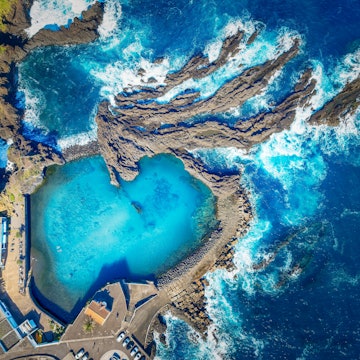

Here are the best things to eat and drink across Portugal © Geber86 / Getty Images
Portugal’s cuisine has been shaped by many factors, from its fertile, sun-baked olive groves and vineyards to its centuries-old love affair with the sea.
Every region has its own unique specialties, which you can find in the mix of old-fashioned tascas (taverns) and more cutting-edge restaurantes helmed by experimental young chefs making waves across the country.
Wherever you go, don’t neglect the simple foods that the Portuguese have refined over the years: freshly baked bread, olives and olive oil, and cheese. They can accompany your lunch or dinner, or you can make a meal of them along with charcuterie and other delicacies best sourced from a local market.
Here are the foods and drinks you shouldn’t miss in Portugal.
1. Salted cod is part of many Portuguese dishes
Portugal’s most famous food is bacalhau (salted cod), which can be served in a seemingly limitless array of dishes. The Portuguese say there are 365 different bacalhau dishes, one for every day of the year. Transforming the fresh white-fleshed fish into bacalhau involves salting, drying and curing, which allows it to last for many months.
Given its longevity, the fish was a staple on long sea voyages undertaken by Portuguese explorers. Among the dishes you shouldn’t miss are bacalhau à bras (shredded cod with fried potatoes and eggs) and our favorite bacalhau com natas (cod baked with potatoes, cream and cheese).
Where to try it: You don’t have to go to a fancy restaurant to find an excellent bacalhau dish. A homespun tavern like Zé da Mouraria serves some of Lisbon’s best traditional fare, including an excellent bacalhau with chickpeas.
Read more: Local Bites: the best places to eat and drink in Lisbon

2. Don’t miss the world’s best custard tart in Lisbon
One of the great culinary wonders of Portugal, the cinnamon-dusted pastel de nata (custard tart), with its flaky crust and creamy center, lurks irresistibly behind pastry counters across the country.
The recipe was born in Belém’s Jerónimos Monastery over 300 years ago. Back then, monks of the Order of St Jerome (aka Hieronymites) used egg whites to starch their monastic robes and thus had many egg yolks left over. Rather than throw them out, some unknown monk found a delicious way to use them.
Where to try it: Going strong since the 1830s, Antiga Confeitaria de Belém serves astonishingly perfect, piping-hot custard tarts. It’s handily located just up the road from the UNESCO-listed monastery that created the original recipe.
3. Feast on fresh-off-the-boat seafood on Portugal’s coast
Always a seafaring people, the Portuguese know a thing or two about cooking fish. Taste the culinary riches of Portugal’s coast in dishes such as caldeirada de peixe (fish stew layered with tomatoes, potatoes and rice), açorda de camarão (a tasty stew of shrimp, garlic and coriander thickened with breadcrumbs), xerém (corn mash made with cockles) or cataplana (shellfish stewed with wine, garlic and tomatoes in a traditional domed copper pan).
Where to try it: You’ll find some outstanding places for a seafood meal along the coast. Mar à Vista serves up a veritable Neptune’s feast to a backdrop of sea views from its location in Ericeira. In the south, O Paulo has equally impressive ocean vistas and some of the best seafood dishes in the Algarve.
4. Taste traditional tripe stew in Porto
Residents of Porto are known as tripeiros, a nickname that means “tripe eaters.” What might sound like an insult is actually nothing of the sort — something that will become immediately apparent when feasting on a savory bowl of tripe stew.
Although you can find the dish in other parts of Portugal, Porto specializes in this delicacy, where it is typically called simply tripas à moda do Porto. It features tripe (cow stomach) with white beans, smoked ham, sausage, carrots, onions and other filling ingredients.
Where to try it: In central Porto, Abadia do Porto has been serving top-notch tripe stew since 1939. If you prefer it as an appetizer, head to Caldeireiros, which serves tripe and many other traditional Portuguese dishes as small plates.

5. Sip port after an atmospheric tour through a wine cellar
While you can taste tawnies, rubies and late-bottled vintages at bars all over Porto, you’ll get far more out of a cellar tour and tasting. Slip over to the other side of the river to Vila Nova de Gaia’s lodges for a spin of barrel-lined cellars steeped in history that hails back to the 17th-century British merchants who developed quite a taste for sweet fortified wine.
Where to try it: At Taylor’s, you can stroll through 300-year-old cellars followed by a tasting in a lovely manicured garden. For more insight into the history of wine and opportunities to order high-quality flights, visit the World of Wine.
6. Indulge in hearty pork dishes and rustic delicacies in the Alentejo
Many Portuguese consider the Alentejo home to some of the best dishes of the hinterlands. Instead of grilled sardines and platters of seafood, you’ll find meaty ingredients like porco preto, a high-quality “black pork” made from pigs that graze on acorns. Rustic ingredients are transformed into delicacies in classic dishes like açorda à alentejana, a soup made of bread, garlic, olive oil, cilantro and a poached egg.
Where to try it: Taberna Típica Quarta Feira serves tender black pork and all the sides inside a convivial dining room in Évora.

7. A francesinha sandwich is northern Portugal’s best comfort food
Porto’s favorite hangover snack, francesinha (which translates to “little Frenchie”), is a thick open-faced sandwich of wet-cured ham, spicy linguiça sausage and steak atop thick bread slices covered with melted cheese, an egg, a hot tomato and beer sauce.
Where to try it: The diner-like Café Santiago in Porto has been serving this rich calorie bomb since its opening in 1959.
There aren’t many vegetarian or vegan dishes
Portugal is a tough place to follow a plant-based diet. Meat and seafood feature heavily on most traditional menus, and even seemingly innocuous dishes can sometimes contain animal products. Caldo verde, for instance, is a soup made with potato and kale, but it often has a base of chicken broth and may also contain sausage.
Your best bet is to seek out dedicated vegetarian and vegan restaurants, which you can find in Lisbon, Porto and the Algarve. A few earth-friendly restaurants worth seeking out are O Botanista in Lisbon, which serves imaginative, beautifully prepared dishes in an elegant setting, and Vegana by Tentugal, where you can tuck into vegan versions of Portuguese classics like the francesinha.
Join the celebrations of flavor at Portugal’s 6 best food and wine festivals
Dates vary for Essência do Vinho, a wine festival in Lisbon, Madeira and Porto.
Chocolate lovers descend on the pretty medieval town of Óbidos for the Festival Internacional de Chocolate, held in late March or early April.
Santos Populares is Lisbon’s lively street party held each year in the first two weeks of June. This is your chance to feast on chargrilled sardines and mackerel.
Monção in the Minho pays tribute to Alvarinho white wine during Feira do Alvarinho in late June or early July.
August’s Festival do Marisco pairs seafood with live music acts in Olhão.
Taste roasted chestnuts and sample wine at Feira da Castanha, held the second weekend of November inside Marvão’s medieval walls.
















